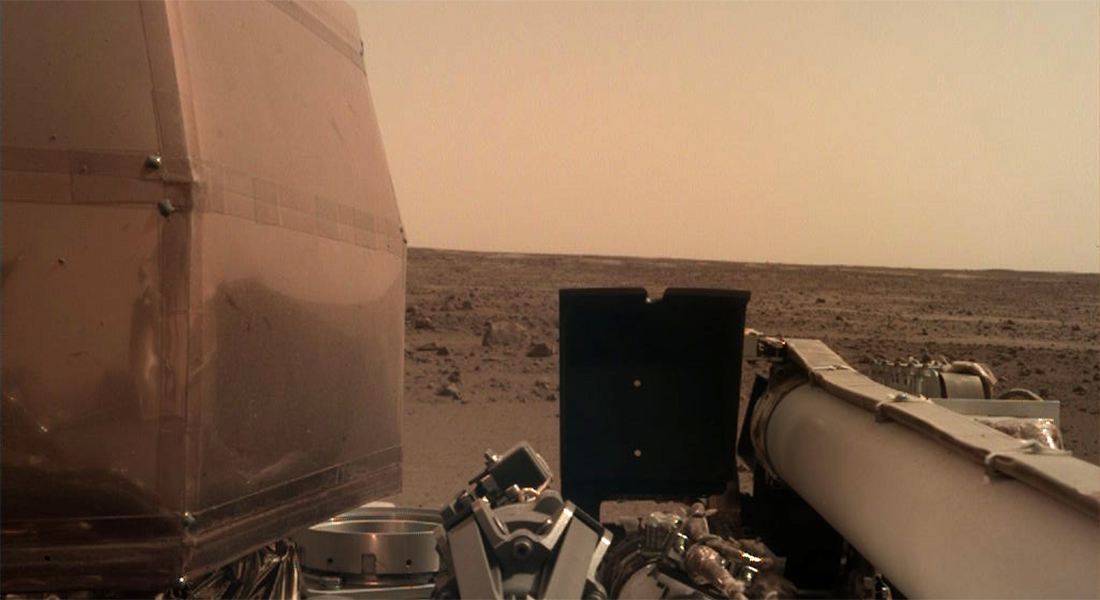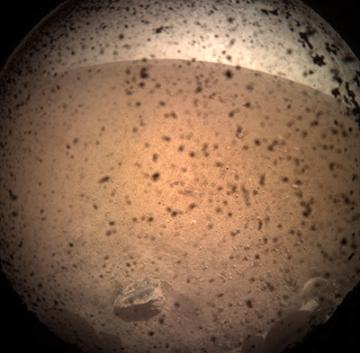
Mission to Mars
Phil Kesten
After almost seven months, and just over 300 million miles, the robotic lander Interior Exploration using Seismic Investigations, Geodosy and Heat Transport—better known as InSight—successfully landed on Mars on Nov. 26.
Manufactured by Lockheed Martin and managed by NASA’s Jet Propulsion Laboratory at the California Institute of Technology in Pasadena, the $814 million effort has links to Santa Clara University. Robin Beck, BSME ’77, and an engineer at NASA/Ames, helped develop the InSight’s heat shield materials. And Kamak Ebadi, an SCU electrical engineering Ph.D. candidate and doctoral research fellow in the Aerial Mobility group at NASA/JPL, was part of the team that helped develop autonomy solutions for InSight, and assisted at JPL’s Mission Control during the landing. We sought out Phil Kesten, SCU associate professor of physics and the university’s associate vice provost of undergraduate studies, for the 411 on the planet and what the probe will be working on during the next two years.
What does NASA hope to achieve with this mission to Mars?
Mars is just plain interesting, so everything we can learn about the planet is important. But the InSight mission has two specific goals: first, to understand how Mars—and other rocky planets—formed, and second, to study tectonic and seismic activity within the interior of the planet. InSight will be able to measure the size of the core, and whether it is liquid or solid. It will be able to measure aspects of the structure of the planet's mantle and crust, as well as seismic activity. Earth, like Mars, is a rocky planet, so learning about the evolution of Mars can also help us learn more about the Earth.

The view from the Mars InSight rover. Photo: NASA/JPL-Caltech
It’s called the Red Planet because Mars has a distinctive red color, which results from iron dust on the planet’s surface. This iron dust has interacted with oxygen in the (thin) Martian atmosphere to form rust—red dust!
Does Mars have seasons?
It does! Seasons on Earth are caused by the tilt of the planet with respect to the plane on which we orbit the Sun. When the northern hemisphere is tilted toward the sun, the Sun’s rays are more concentrated on that part of the globe, so it’s warmer—which would be summer. And of course, when the northern hemisphere is tilted toward the sun, the southern hemisphere is tilted away, sunlight is less concentrated—so it’s winter.
Mars is also tilted with respect to the plane on which it orbits the sun, so it experiences the same kinds of seasons—winter, spring, summer, fall—as we do. In addition, because the orbit of Mars is more elliptical than Earth’s, it’s much farther from the sun when it’s at the far extreme of its orbit than when it’s at the near extreme. So Mars also gets some seasonal effect from its changing distance from the Sun. Earth’s orbit is relatively circular, so we don’t experience those kinds of seasons.
What makes up its atmosphere?
Most of the atmosphere, about 95 percent, is carbon dioxide. There is a bit of nitrogen and argon, and a small amount of oxygen. There are also small amounts of other gases, and yes, there’s a bit of water in the atmosphere. The Mars atmosphere is relatively thin, compared to our own—about 150 times thinner. But there is enough atmosphere, for example, to use a parachute to bring the InSight lander safely down to the surface.
Do we have any evidence that life once existed on Mars?
No, at least not yet. But a meteorite (Allan Hills 84001, found in Antarctica in 1984), which is unequivocally traced to Martian origins, appears to show a fossilized microorganism. Not all scientists agree on this, but it is, at the very least, intriguing. The Allan Hills meteorite, which was flung off from Mars during a meteorite impact on that planet, appears to show a fossilized microorganism.
Could it support human life in the future?
There is water on Mars, as well as water ice, and the temperature is habitable. And although its atmosphere is thin now, there is some evidence to suggest that Mars once had a much thicker atmosphere.
How about the volcanoes on Mars? How are they different from Earth’s volcanoes?
There are volcanoes on Mars and measurements made by NASA’s Mars Global Surveyor spacecraft, launched in 1996, reveal that Olympus Mons rises nearly 14 miles above the surrounding plain. That’s more than twice as tall as Mauna Kea, one of Earth’s largest volcanoes. Olympus Mons, and three other smaller volcanoes, can be seen rising dramatically above the Martian plains from Mars Global Surveyor data. Scientists aren’t sure whether Olympus Mons is extinct, or whether it might erupt again in the future. It is certainly true that we have no evidence of recent volcanic or seismic activity on Mars, but although many scientists have thought that Mars is no longer geologically active, that conclusion has recently been called into question. We will very likely learn more from the InSight mission.
For live updates, go to www.jpl.nasa.gov

